Dwarves and Medici in Florence
By Dan Morey
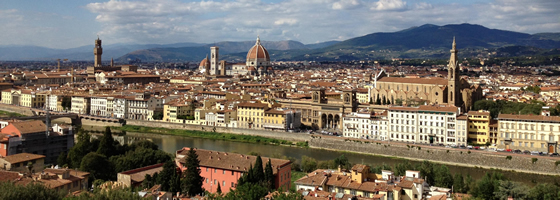
Mother was up, showered and dressed by eight o’ clock. It surprised me to see her so sprightly after a full day in the Uffizi. Post-museum mornings usually require an intravenous infusion of Folgers crystals just to activate her pulse.
“What got into you?” I said.
“I think it’s the sun. Isn’t it glorious? I may never go back to Pennsylvania again.”
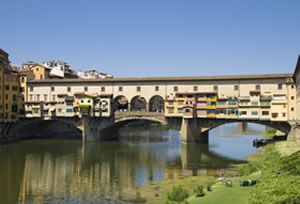
Outside, the streets of the Renaissance city were quiet. We made our way to the creatively named Ponte Vecchio, or “old bridge,” on the Arno River, where the jewelers and goldsmiths were just opening shop. All along the bridge, precious metals and gems glittered in the windows.
Prior to 1593, the Ponte Vecchio had been lined with butchers selling boars’ heads, beef hearts, and loads of stinky lampredotto. Grand Duke Ferdinando I de’ Medici had to cross this tripe-filled span every day on his way to the Palazzo Vecchio, Florence’s city hall. As he passed, the macho meat cutters would smirk at his tights and say, “Hey lady, how about a nice pork today?” Tired of the slurs and gamy stench, Ferdinando banished the butchers, replacing them with retailers of luxury goods.
The Grand Duke’s sentence seems a bit harsh, considering he could’ve easily avoided the butchers (though not their odor) by using the convenient overhead walkway his father Cosimo had installed on the Ponte Vecchio in 1565. This passage, known as the Vasari Corridor (after its architect, Giorgio Vasari), runs from the Palazzo Vecchio to the Pitti Palace across the river. On the way, it goes through the Uffizi (Medici offices at the time), and Santa Felicita church. By using the Vasari Corridor, the Medici could effectively live, work, and attend mass in Florence without meeting a single commoner.
As we mounted the bridge, the shiny rings and necklaces in the shop windows mesmerized Mother.
“Ooh,” she said. “Look at that.”
If left unchecked, gawking of this sort will inevitably lead to shopping. I’ve found that providing a distraction is often effective, so I whipped out the Baedeker guide.
“Hmm,” I said. “Did you know that Mussolini and Hitler held a meeting right here, on the Ponte Vecchio, in 1938?”
“No,” said Mother, veering toward a jewelry store.
“It’s true,” I said. “If you stand over here and look up—up—you’ll see the Vasari Corridor. It was in this secret passage—look up—that the two dictators signed their infamous Pact of Steel.”
“You don’t say.”
She was on the move again, her eyes locked onto a golden bracelet. I cut her off, and continued my discourse: “I do say. And there’s more. Hitler liked the Ponte Vecchio so much that he refused to blow it up during the German army’s retreat. He destroyed the buildings on either side instead, blocking the Allies’ access.”
“Uh-huh,” said Mother, maneuvering into an evasive spin, “I think I heard about that.”
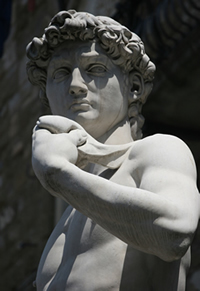
Eye contact with a merchant had been established. “Pay attention,” I said, taking her by the sleeve. “You’re walking right by these historic windows and not even looking at the view. Mussolini put them in for Hitler, so they could make out while watching the sunset over the Arno.”
“Stop talking nonsense and let me go!”
“Wait!” I said. “Take my picture!”
I’d snapped so many shots of Mother and David in the Piazza della Signoria yesterday that she couldn’t possibly refuse. “Oh, all right. Where?”
“Down there, towards the other end.”
“Daniel, I want to look at the shops!”
“We will. On the way back.”
Through these subterfuges, I was able to get her across the bridge without incident or expense. Our destination was the Pitti Palace, home to multiple generations of Medici, and now a museum. My plan: arrive before the tour buses.
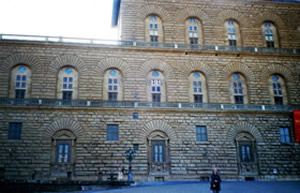
The road to the Pitti is graded, and when we came over the rise, the monstrous bulk of the palace bulged into view. The Pitti looks more like an ashlar fortress than a home, with little decoration besides the rows of closely spaced, arched windows on every floor. The effect is dull and repetitive, but very imposing.
The Medici filled the house with luxurious furnishings, fine art and antiques. They also converted the hill out back into the renowned Boboli Gardens, which is where Mother and I started our tour. On the lowest level is a statue-rimmed amphitheater with a central basin from the Baths of Caracalla in Rome. We climbed higher, to Neptune’s fountain, and higher yet, to the Garden of Cavaliers. Along the way, we turned to look down at the palace and the city of Florence beyond. Giotto’s campanile, Brunelleschi’s dome, and the tower of the Palazzo Vecchio soared above the sea of red tile roofs.
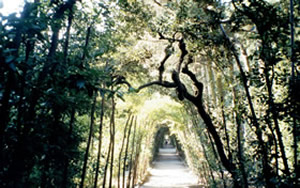
Mother stopped at the summit of Boboli hill, while I continued down the other side. The main lane of descent, the Viottolone, is dotted with classical statuary. I went off to the side, into the woods, where bending Holm oaks form a latticework tunnel. At the bottom, the forest opens up, revealing the secluded Isolotto, a landscaped island in the center of a pond.
I sat down at the edge of the water and savored the atmosphere of ruined glory. The large, gurgling fountain that dominates the island shows the god Oceanus, ruling over smaller figures that represent the Nile, Euphrates and Ganges rivers. I tried to picture it in Medici times, before the marble was stained and the noses of the deities were chipped away.
I poked around, exploring paths through the exotic vegetation (imported by the Medici from all over the globe) and listening to the twittering birds. Though this sylvan retreat is mentioned in all the guidebooks, I felt as if I’d discovered it. Unfortunately, thanks to an American family bearing a picnic brunch, my solitude lasted only a quarter hour. As they tramped through a bed of sedum, one of the children whined, “But Daddy, I have to wee!”
“Go over there,” said Daddy. “No one’s around.”
The kid barged into my glen, fiddling with his fly, and I bolted back up the Viottolone, avoiding a potentially embarrassing, possibly criminal, scene: “I tried to wee, Daddy. But that man was in the bushes!”
There are a lot of treasures to see inside the Pitti Palace, but after the Uffizi, we were arted-out. We roamed around the galleries trying to guess which decorative features were real and which were painted on the wall using the 3D trompe l’oeil technique. I beat Mother by two columns and a putto.
After lunch in the museum café, we went to the rear of the palace to visit the statue of Morgante, Cosimo I ‘de Medici’s prized dwarf. He sits, naked and pugnacious, astride a tortoise, one hand on his hip, the other raised threateningly. “Halt!” he seems to say. Even the tortoise is truculent, spitting water at those who venture too close to his toilet-shaped bowl.
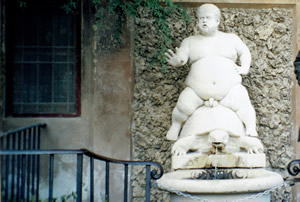
Morgante had every reason to be testy. Mentally ill children were considered prime court entertainment, as were natives from the Americas and, of course, little people. Besides the general buffoonery that was expected of him, Morgante was often made to fight monkeys in front of the duke and his cronies. The dwarf excelled in these battles and usually left his simian adversary insensate on the floor.
Morgante’s moniker itself is a typical example of the sort of thing the Medici found funny. They named him after the titular character in a play about—wait for it—a giant. Cosimo thought the joke so funny he named his next dwarf Morgante as well. And the dwarf after that, and the dwarf after that. Great cultural advancements were achieved in Florence during the Renaissance, but humor wasn’t one of them.
Mother snapped my picture beside the fountain, and we bid a fond farewell to the Pitti Palace and its wonders. As we walked down the stone drive toward the river, I informed Mother that the Ponte Vecchio was closed for the day, and that we’d have to take a different route back to the hotel. She was not inclined to believe me. We returned many hours later, laden with overpriced trinkets. Grazie, Ferdinando.
About the author

Dan Morey is a freelance writer in Pennsylvania. He’s worked as a book critic, nightlife columnist, travel correspondent and outdoor journalist. His writing has appeared in Hobart, decomP, McSweeney's Quarterly and elsewhere. He was recently nominated for a Pushcart Prize, and is currently working on a memoir about taking his mother on a trip to Ireland and Italy. Find him here.
Did you like the article? Subscribe here to our New Article Email Alert or RSS feeds.
Sharing is caring! Don't forget to share the love, and keep the conversation going by leaving a comment below:
Advertisement
